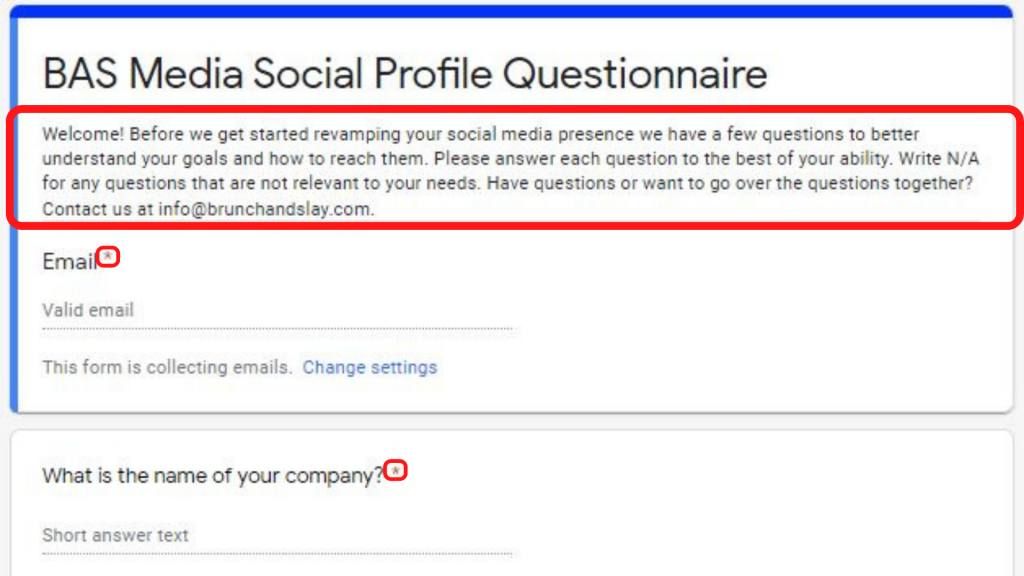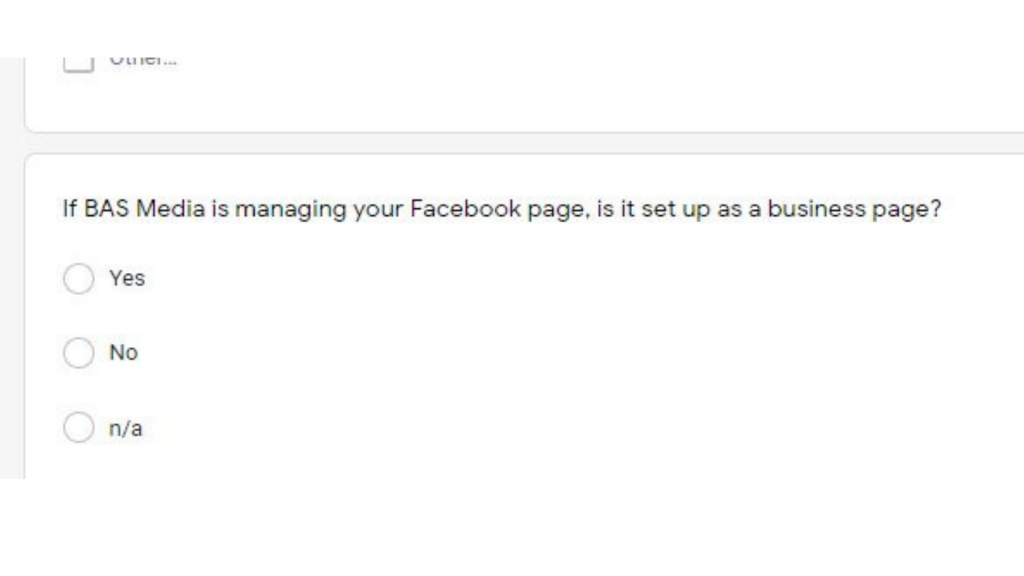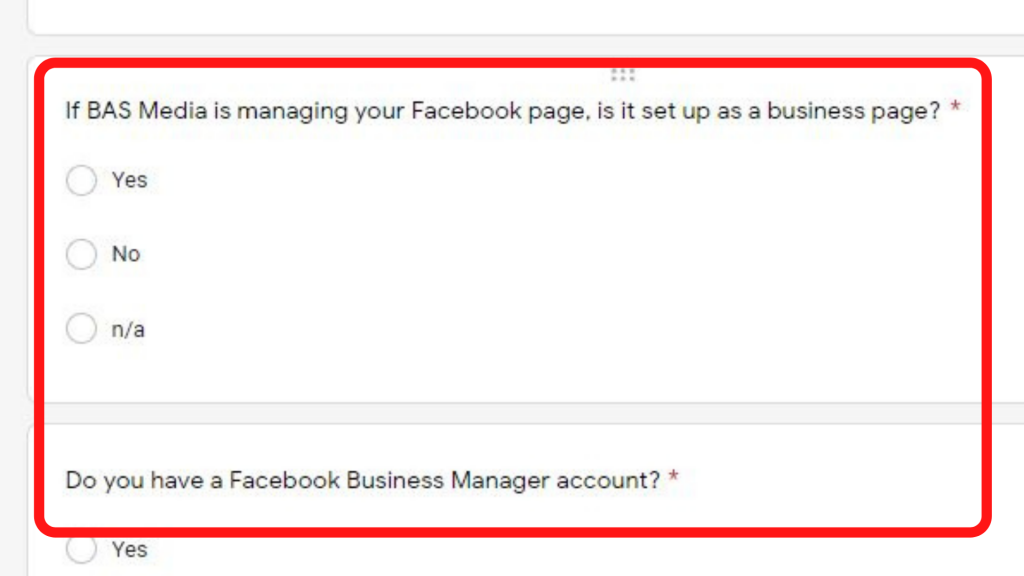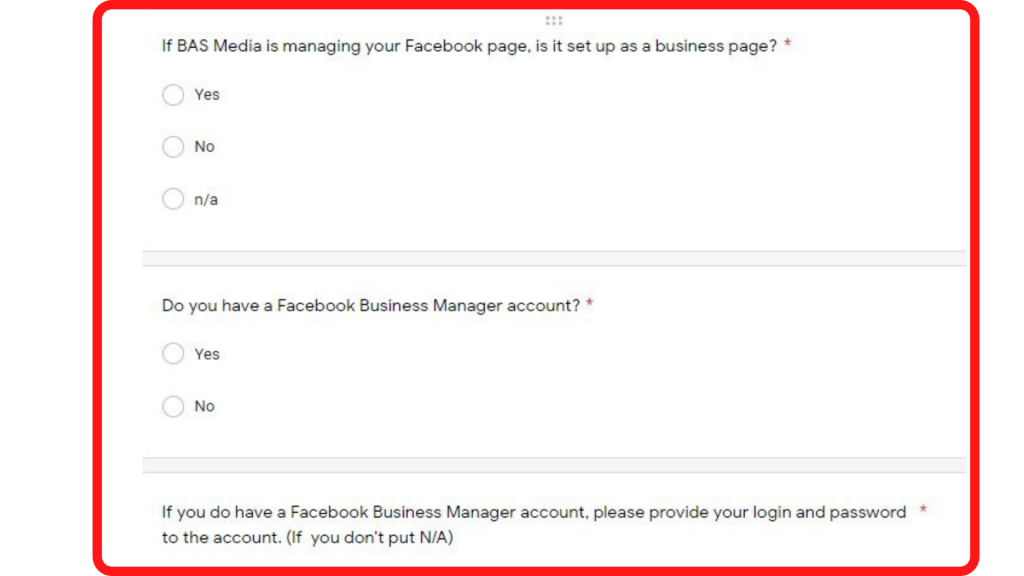Social Media Onboarding Process
Strategy | UX Copywriting | Research | Revision
I worked with a startup marketing agency (BAS Media) on a variety of social media and digital marketing projects. While onboarding new clients, I was tasked with creating digital forms for the social media part of the process.
Limitations
While creating the social media onboarding process, there were a few limitations I had to work around:
- Limited contact with the client to ask questions and get feedback
- Delayed communications due to work schedules
- Limited access to the company’s daily business due to remote locations
Problem / Statement
The marketing agency team lacked a way to collect client information in an organized and effective way to relieve internal frustrations and improve client communications.
——–
How might we work around communication limitations, alleviate internal frustrations, and effectively collect information to manage client accounts?
Goal
Develop a process to collect the necessary information to effectively manage clients’ social media accounts. The process will:
- Collect contact information, account logins, brand goals, etc.
- Instruct clients on how to create and add administrative roles and update account permissions, which would allow the marketing team to begin managing their social media accounts.
- Provide clients with insight into our process and explain why we are collecting this information.
What I did
- Walked through each signup and account creation process and created comprehensive how-to guides.
- Collaborated with team members from different departments to better explain parts of the process that would directly impact clients.
- Collected and implemented client feedback.
- Observed client behaviors and updated the form’s microcopy to create clear and concise explanations for different questions.
Finding & Fixing Friction

While observing the clients, I found several friction points. Clients would skip questions or entire sections. They believed the questions were so similar that the agency could use their previous answers.
We planned to keep the form concise to make it as quick as possible for clients to fill out. We realized, since we wouldn’t be around when the client was filling out the form, we needed to prioritize clarity over length. This was to ensure we were getting complete and accurate information.
To do this, I explained in our intro section the benefits of the client filling out every single question and section. I explained that their answers would help us better understand their social media goals.

I made sure to repeat this explanation throughout the form to maintain that each question/section is important to their social media success.
I also made each question/section required to submit the form. The purpose was to remove the obstacle of working with limited information due to unanswered questions.
Filter & Collect



After the first client filled out the form, our website administrator learned they needed to access the client’s Facebook Meta Pixel upfront to begin updating their website.
Due to previously mentioned limitations (delays, etc.), it took longer than expected to receive this information. To avoid this specific delay in the future, we decided to gather the client’s Facebook business manager login in the onboarding form.
The first additional question allowed us to filter and separate Facebook clients.
The second additional question allowed us to collect the clients’ Facebook business manager logins.
From there, we were able to launch our social media and website services in the same step.
Additions & Removals

As I assessed what was and wasn’t needed in this form, I decided to add and remove certain sections.
One of the sections I removed was an instructional section guiding the client to add one of our team members to their Facebook business page. I decided to remove this section and instead collect the login information and add a team member ourselves. This decision was meant to cut down on unnecessary communication and simplify the onboarding process for the client.

I also decided to add a contact question. The intention behind this was for the company to designate a contact person to whom we could send any questions or concerns that specifically regarded the onboarding process. I made sure to explain why we are asking for a contact person.
Outcome: A more effective process
This form started as a simple list of the information our team needed to manage social media accounts. It was developed into a comprehensive submission form to set up our team to successfully launch social media campaigns, website redesigns, and more.
We were able to work through the different points of friction and explain why this information was so impactful. The form has different types of microcopy, including conversational and instructional copywriting.
